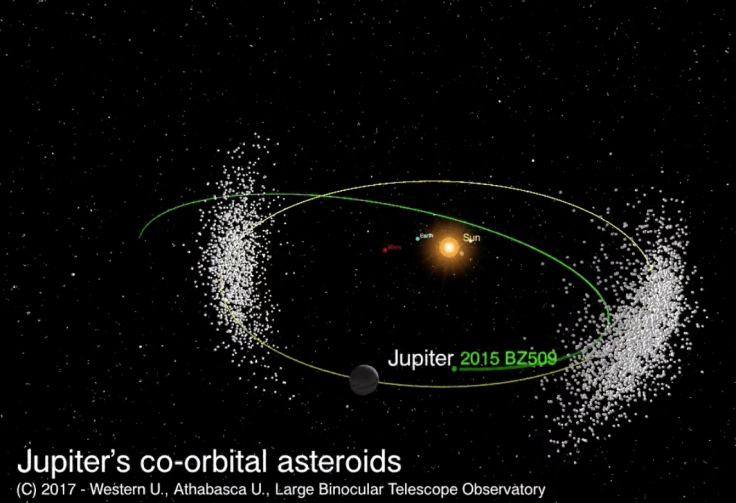Astronomers Discover Asteroid Playing A Cosmic Game Of Chicken With Jupiter

Most objects in our solar system circle the sun in what’s known as a prograde orbit, wherein their motion is counter-clockwise when seen from “above.” All but a handful of the million or so known asteroids in our solar system exhibit prograde motion — a direction inherited from the spinning disk of debris that birthed them roughly 4.6 billion years ago.
Astronomers using the Large Binocular Telescope in Mt. Graham, Arizona, have now discovered an asteroid orbiting the “wrong” way — exhibiting retrograde motion — around the sun. Moreover, this asteroid, 2015 BZ509 (“Bee-Zed” for short), also shares Jupiter’s orbital space, making it the only known object in the solar system to have a retrograde orbit and to share a planet’s orbital space.
The observations were detailed in a study published Wednesday in the journal Nature.
“If you imagine the solar system as a race track where the planets are these monster trucks and the asteroids are these ridiculously small clown cars going around the sun, they’re all going in one direction except for a few oddballs like Bee-Zed,” study co-author Paul Wiegert from Canada's Western University’s department of physics and astronomy said.
Jupiter, which is the most massive planet in the solar system, is surrounded by Trojan asteroids that share its orbital path and direction. These 6,000 or so objects are clustered in the two stable Jupiter-Sun Lagrange points 60 degrees ahead and 60 degrees behind the planet in the orbit. Since these asteroids are present in stable points, and since they are locked in prograde orbits, they do not (and will not) collide with the gas giant.
This is what makes Bee-Zed — discovered in 2015 — a unique object. It’s an asteroid in a retrograde orbit “playing a cosmic game of chicken” with not just Jupiter, but also with its 6,000 asteroids. Surprisingly, calculations carried out by the researchers suggest that it has been locked in this orbit, which see-saws it above and below the plane of the solar system, for at least a million years.
“Bee-Zed manages to avoid Jupiter by swerving around it at just the right moment and Jupiter’s gravity actually helps it do that,” Wiegert explained. “It traps it in this kind of state and protects it.”
The question, then, is how did this asteroid get locked in this peculiar and surprisingly stable orbit? For now, the answer is far from clear.
“Bee-Zed might be an ordinary asteroid that just got into a strange state through an extraordinary set of coincidences, or it might be something fundamentally different,” Wiegert said. “The detective work has just begun.”
© Copyright IBTimes 2024. All rights reserved.






















